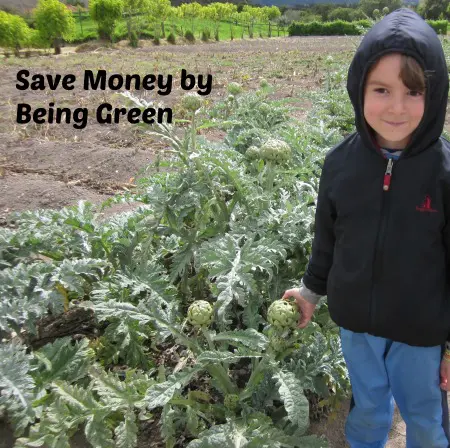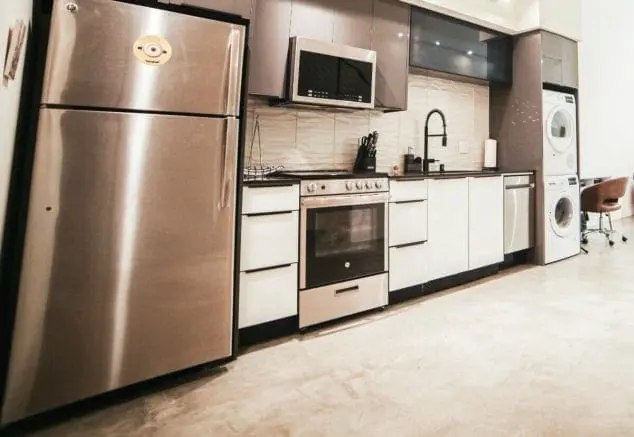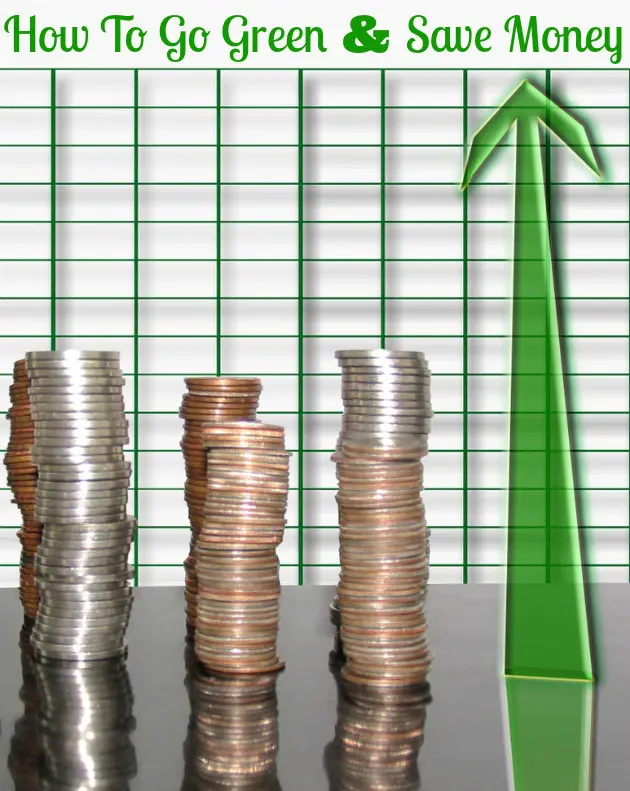If you’re looking for ways to save money, going green can benefit your wallet and mother nature at the same time. While organic food and wind power are often more expensive than conventional food and energy, it is possible to help the planet and put a little money away while you’re at it. If you think going green is too expensive, think again! Here are 20 simple ways for how to go green at home and save money at the same time.
How Can I Go Green at Home and Save Money?
People often ask, “Does going green save money?” Well, not necessarily, but is certainly can. If you’re a fan of saving the environment like I am and you want to save your money as well, I don’t blame you! When you use green friendly products around your household, you probably don’t want to set out and pay top dollar. Instead, I want to give you a few tips that you can use when you’re looking to save money by being green.
20 Inexpensive Ways To Go Green At Home
It can actually be pretty easy to go green at home and reduce expenses. Here are 20 ways to go green at home and save green too!
1. Go Paperless
You can save money and have a positive effect on the environment by asking your billers to send you paperless statements. Since some service providers charge a fee if you request a paper statement, you’ll save money by opting out and going electronic. Plus, you’ll save big on postage and time by paying everything online. Having your bills sent via email will lessen your carbon footprint as well. There are many more ways to reduce paper consumption as well.
2. Reduce Home Energy Expenses
Another simple solution for how to go green at home is to change just one 75-watt light bulb to a more energy-efficient compact fluorescent light bulb (CFL) and you’ll save your family as much as $60 a year in energy costs. Since lighting accounts for almost 25% of the average home’s electricity bill, these savings add up quickly. You can also save by unplugging those rarely used appliances, turning lights off when they’re not necessary, and switching off your personal computer at bedtime. A free energy audit from your provider will help point out the areas most in need of improvement. Here are 20 green ways to lower your electricity bill.
3. Shop at a Local Farmer’s Market
Local farmer’s markets have the same quality produce – if not better – than your national grocer, and at a much cheaper price. Locally grown fruits and vegetables bypass the packaging and distribution costs of the major producers, which not only saves you money, but cuts down on delivery trucks’ CO2 emissions. Buying local produce sans packaging also helps reduce the influx of BPA-laden, non-decomposable packaging. Support your local farmers, especially those using organic or certified natural methods. Visit Local Harvest to find farms, farmer’s markets, CSA’s, and co-ops in your area.

4. Plant a Backyard Garden
What’s even cheaper than a farmer’s market? Your own land. Purchase seeds, buy a small gardening kit, and watch your veggies grow as you start a home garden. Keep an eye out for insects, monitor your watering, and make sure you know when to plant and when to pick. Growing your own organic edible garden is a great answer to how to go green at home and nothing tastes quite as good as a salad you truly made from scratch. It doesn’t have to be huge, but you’re going to find that even if you grow a small garden in your back yard, it can save you a money. Gardening is fun to do and it is fun to see just how many vegetables one plant can actually grow.
5. Buy Used Electronics
If you’re in the market for an electronic device such as a laptop computer or a smart phone, research eBay or Amazon for used items. You’ll frequently find deals on items categorized as “like new.” Just make sure to check each vendor’s track record and understand their return policy. Also, recycle your devices to reduce e-waste, and make that landfill one iPhone smaller at a time.
6. Wrap Your Water Heater
Since being green means saving energy, you’re going to want to probably use as little of it as possible. Did you know that if you wrap your hot water heater with a specialized blanket, you can save 15-20% off your bill? If you’re going to do this tip to save money by being green, make sure you get a blanket designed for a water heater for safety.
7. Wash In Cold Water
Yes, I said cold water- it is a super easy way to go green and save money. Your laundry will be effectively cleaned, and you’ll save energy not using heated water (not to mention it will keep your electric/gas bill lower). Tide even makes a cold wash detergent.
8. Skip The Dryer
If you are able to use an outdoor clothesline, by all means harness the sun’s energy to dry your laundry instead of using a dryer. Community deed restrictions, apartment/condo dwelling, weather, and other factors often make outdoor drying impossible though. In those cases, utilize your indoor space to air dry at least some of your laundry. An inexpensive garment rack or shower rod will work wonderfully. Not only will you reap the benefits of a lower electric or gas bill, but your clothing will last longer not going through the wear and tear of the dryer. Skipping the dryer is an easy way to save money being green.
9. Don’t use the heated dry feature on your dishwasher
One of the more simple ways for how to go green at home is to just not select the heated dry option on your dishwasher. Push the eco button, don’t push the heated dry option, or simply turn off the dishwasher at the end of the wash cycle, and leave the door ajar slightly to allow dishes to air dry.
10. Create your own cleaning products
There are some cool recipes online that you can use when you’re looking to create your own eco-friendly cleaning products. Instead of buying name brands, household items such as vinegar, baking soda, and more will do the trick. Check your local library for books such as Clean House, Clean Planet by Karen Logan to find specific recipes and instructions for making many different types of cleaners. Make your own garbage disposal cleaner. Or use Google and search for “eco-friendly household cleaner recipes” to see for yourself many cleaning recipes to save money by being green.
11. Skip on the bottled water
Not only do those little bottled water containers hurt the environment, you’re spending too much money. Instead, you’re going to want to invest into a simply water bottle and filter. Many of these filters can filter out 500 gallons of water! You can also find stainless steel, BPA-free reusable water bottles at prices that won’t break the bank in a variety of stores such as Marshall’s, TJMaxx, Target, and Walgreens.

12. Take a close look at your appliances
If you have older appliances that aren’t energy efficient and you’re thinking about getting new ones, you will want to highly consider an energy efficient appliance set. New Energy Star appliances such as your Washer, Dryer, and many other items can save you hundreds, if not thousands of dollars over its life time. As Consumer Reports says, “If you’re looking to cut energy use in your home—and lower your energy bill—newer appliances are the key.”
13. Use cloth napkins instead of paper napkins
A friend blessed me with a beautiful king sized sheet, but I don’t have a king sized bed. I cut it into 16-inch squares and stitched the edging by hand (I don’t have a sewing machine). My family has lovely cloth napkins that can be washed and used again and again. Use fabric remnants you already have or search for inexpensive fabric at thrift stores.
14. Start a compost pile
It’s a great way to reuse vegetable and fruit scraps, thus cutting down on the amount of trash you’re sending to the landfill. Visit Composting 101 for specific information on what to compost and how. If you cannot have a compost pile where you live (i.e. you’re renting, it’s forbidden by community deed restrictions, wildlife such as venomous snakes make it dangerous, etc.), consider making a homemade tumbler out of a garbage bin. You’ll end up with a nutrient-rich soil that’s fabulous for your lawn, outdoor plants and/or garden. You’ll save money because you won’t have to buy fertilizer and soil enrichment products.
15. Reuse your old or worn out clothing
Socks can be use for cleaning window blinds and ceiling fans. T-shirts can be turned into cleaning rags. Jeans and other clothing items can be redesigned into a rag quilt. You can even turn old t-shirts into a homemade pet bed!
16. Don’t allow the water to run while you brush your teeth
It seems logical enough, but how many people are guilty? My husband for one! Not only will you save a precious resource, you’ll cut down on your water bill if you are charged for your usage.
17. Reuse glass jars
Glass doesn’t leach chemicals, so it’s a far better choice for storage than plastic. Jelly jars, mayo jars, pasta sauce jars … you name it … are fantastic for storing dried beans, popcorn, nuts like almonds, pecans, and walnuts, dried herbs, etc.
18. Shop yard sales, thrift stores, and rummage sales
Buying used instead of new is a great way to go green and save money. Plus, thrift store shopping will lessen the load on our landfills and can help reduce our dependence on petroleum.
19. Combine trips
Planning your trips is one way to shop sustainably to combine as many errands/stops as possible and reduce your vehicle’s mileage and fuel consumption.
20. Reuse junk mail
Don’t forget to reuse your junk mail. Any paper without writing can be reused for making shopping lists, library lists, children’s art doodling, etc. When you’re finished, add it to your paper recycling bin, and take pride that you gave it a second life.
Conclusion
Sure, some of these green tips can be rather simple, but by using them, you should be able to save! Test these eco tips out and see how much you save. Not only are you going to be helping your wallet, you’re going to help the environment as well!
What works for one household may not work for yours. If you live in the Midwest, installing home solar panels is unlikely to have a significant effect on your carbon footprint or your monthly bills. If you live in the Southwest, you’re not going to get a lot out of a water-mill. Do your research and find out what works best in your area. Weigh the cost of purchase and installation against future savings, and chances are that you’ll end up conserving more than just natural resources.
I hope you enjoyed learning these ways to go green and save money at the same time. What other ways can you think of for how to go green at home and save money at the same time?
Related Posts:



Mauro says
Hello from G&M Mondays. Best way for me is what you mentioned: buy used, but also sell used. There are plenty of places you will find online and locally that will pay you for recycling. Earth911.com, for example, is a good place to start for finding local recycling centers.
Morgan Palino says
Wow, superb blog layout! How long have you been blogging for? you make blogging look easy. The overall look of your website is excellent, let alone the content!. Thanks For Your article about How to Go Green and Save Money at Home | Family Focus Blog- mom blog on parenting and family topics .